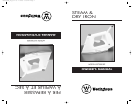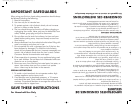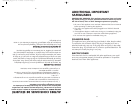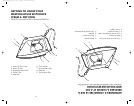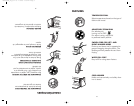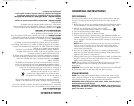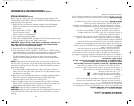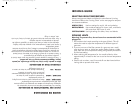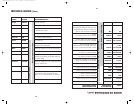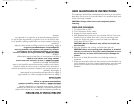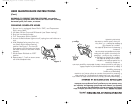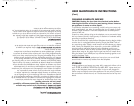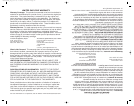USER MAINTENANCE INSTRUCTIONS
(Cont.)
CLEANING SOLEPLATE SURFACE
CAUTION: Unplug the Iron from the electrical outlet before
cleaning the exterior of the Iron and storing. Never immerse
an appliance in water or other liquid.
To protect the soleplate from scratching, avoid ironing over snaps, zip-
pers, metal buttons, etc. Also, do not place the iron on metal or rough
surfaces. Slight scratches in non-stick soleplates do not affect perfor-
mance of the iron.
If starch or other residues cling to the soleplate, use a commercial type
hot iron cleaner (found in local grocery or discount or hardware stores)
according to products directions.
The Iron should be fully cooled before Soleplate cleaning begins. Make
sure the Iron is unplugged before cleaning. Empty the Water Tank of
any remaining water. Apply a small amount of mild cleaner to a damp
cloth. Gently rub Soleplate, then wipe with a moist cloth. NEVER USE
scouring pads or abrasives cleaners on the Soleplate, as this may
scratch the surface. Wipe all other surfaces with a slightly damp cloth.
Never allow water or any other liquid to get into the unit, except when
filling the Water Tank. NEVER put any chemical cleaning agents or sol-
vents in the Water Tank.
BEFORE USING AGAIN, preheat and move Iron over an old cloth
several times to remove any residue from the Soleplate.
STORAGE
Unplug appliance and empty any water left in water tank. Allow unit to
cool. STORE IN UPRIGHT POSITION ON HEEL REST. Never store Iron
lying on the Soleplate. Never store it while it is hot or still plugged in.
Never wrap cord tightly around the appliance. Do not put any stress on
the cord where it enters the unit, as it could cause the cord to fray and
break.
13
13
ENTRETIEN (SUITE)
NETTOYAGE DE LA SEMELLE
MISE EN GARDE : Débrancher le fer avant d’en nettoyer
l’extérieur et de le ranger. Ne jamais immerger l’appareil
dans l’eau ou tout autre liquide.
Pour éviter d’égratigner la semelle, éviter de repasser les boutons-
pression, les glissières, les boutons en métal, etc. Ne pas déposer le fer
sur des surfaces en métal ou rugueuses. De légères égratignures sur la
semelle antiadhésive n’ont pas d’incidence sur le rendement du fer.
Si de l’empois ou d’autres résidus adhèrent à la semelle, utiliser un
nettoyant à fer commercial (qu’on trouve dans les épiceries, les
magasins à rabais et les quincailleries) et se conformer aux instructions.
Laisser le fer refroidir complètement et s’assurer qu’il est débranché
avant d’en nettoyer la semelle. Vider complètement le réservoir d’eau.
Appliquer une petite quantité de nettoyant à l’aide d’un linge humide.
Frotter doucement la semelle, puis l’essuyer avec un linge humide. NE
JAMAIS UTILISER de tampon récurant ou de nettoyant abrasif sur la
semelle, au risque de l’égratigner. Essuyer toutes les autres surfaces
avec un linge légèrement humide. Ne jamais laisser d’eau ou d’autre
liquide pénétrer dans le fer, sauf lorsque vient le temps de remplir le
réservoir. NE JAMAIS verser de nettoyants chimiques ou de solvants
dans le réservoir d’eau.
AVANT DE RÉUTILISER LE FER, le faire chauffer et le passer à
plusieurs reprises sur un vieux linge afin de retirer tout résidu de la
semelle.
RANGEMENT
Débrancher le fer et vider le réservoir. Laisser le fer refroidir. LE
RANGER EN POSITION VERTICALE, EN APPUI SUR SON TALON. Ne
jamais le ranger sur la semelle. Ne jamais ranger le fer s’il est encore
chaud ou branché. Ne jamais enrouler le cordon serré autour du fer.
Ne pas causer de tension sur le cordon là où il est raccordé au fer, au
risque de l’endommager et de le briser.
WST5000ZE_IB_13-1-05 1/13/05 3:09 PM Page 25



